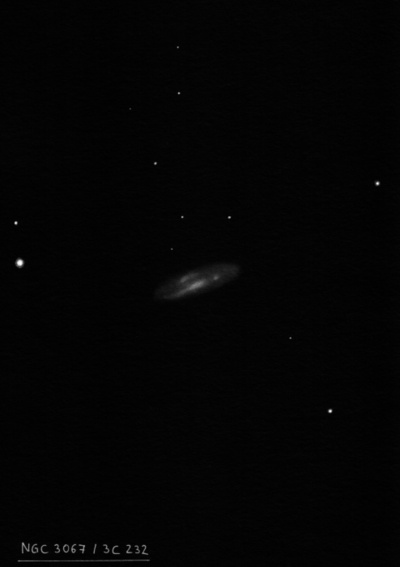
William Herschel discovered NGC 3067 = H II-492 = h657 on 7 Dec 1785 (sweep 487) and noted "pB, pL, lE nearly in the parallel." John Herschel made 3 observations and wrote on 6 Mar 1828 (sweep 128), "pB; pL; E in parallel; gbM; 60" l, 40" br; has a * 10th mag n f."
A total of 15 observations were made at Birr Castle. On 13 Mar 1850, LdR (or assistant George Stoney) noted the following detail: "Longitudinal split visible occasionally, at least in following 2/3. A bright streak seemed to run transversely across neb."
200/250mm - 8" faint, very elongated ~E-W. A mag 9 star is 4' E.
400/500mm - 17.5" (4/13/91): moderately bright, moderately large, elongated 5:2 WNW-ESE, brighter core bulges but no nucleus, extensions taper towards ends. Located 3.8' WSW of a mag 9.5 star.
600/800mm - 24" (3/28/17): at 260x; fairly bright, moderately large, elongated 5:2 WNW-ESE, brighter elongated central section is mottled and appears to have a sharp light cut-off (dust lane) on the northern flank, the eastern end of the galaxy has a lower surface brightness, probably due to dust. Member of the USGC U268 group.
3C 232 = Ton 469, a distant quasar with a redshift of z = .531 (light-travel time of 5.3 billion years), lies 1.9' due north. It was easily visible at 375x as a very faint mag 16 star. A brighter mag 15 star is 1.4' WSW of the quasar. This QSR was central to another Arp controversy as a “HI finger” or bridge appears to connect the quasar and NGC 3067.
24" (4/20/14): fairly bright, elongated 5:2 WNW-ESE, 1.3'x0.5', contains a large bright core that is very mottled with several very small knots (HII regions and dust on the SDSS). The southeast side of the halo is weaker with an irregular surface brightness. A mag 9.8 star is 3.9' ENE.
Notes by Steve Gottlieb